Moravian Church

Moravian Church

| Unity of the Brethren | |
|---|---|
| Unitas Fratrum | |
| Classification | Protestant |
| Orientation | Hussite with Lutheran Pietist influences |
| Founder | followers of Jan Hus and Petr Chelčický |
| Origin | 1457 Bohemia |
| Congregations | 1,000+[1] |
| Number of followers | 1,112,120 (2016)[2] |
The Moravian Church, formally named the Unitas Fratrum (Latin for "Unity of the Brethren"),[3][4][5] in German known as [Herrnhuter] Brüdergemeine[6] (meaning 'Brethren's Congregation [from Herrnhut]', the place of the Church's renewal in the 18th century), is one of the oldest Protestant denominations in the world, with its heritage dating back to the Bohemian Reformation in the 15th century and the Unity of the Brethren (Czech: Jednota bratrská) established in the Kingdom of Bohemia.
The name by which the denomination is commonly known comes from the original exiles who fled to Saxony in 1722 from Moravia to escape religious persecution, but its heritage began in 1457 in Bohemia and its crown lands Moravia and Silesia, then forming an autonomous kingdom within the Holy Roman Empire. The modern Unitas Fratrum, with about one million members worldwide,[1] continues to draw on traditions established during the 18th century. The Moravians continue their tradition of missionary work, such as in the Caribbean, as is reflected in their broad global distribution. They place high value on ecumenism, personal piety, missions, and music.
The Moravian Church's emblem is the Lamb of God (Agnus Dei) with the flag of victory, surrounded by the Latin inscription "Vicit agnus noster, eum sequamur" ('Our Lamb has conquered, let us follow Him').
| Unity of the Brethren | |
|---|---|
| Unitas Fratrum | |
| Classification | Protestant |
| Orientation | Hussite with Lutheran Pietist influences |
| Founder | followers of Jan Hus and Petr Chelčický |
| Origin | 1457 Bohemia |
| Congregations | 1,000+[1] |
| Number of followers | 1,112,120 (2016)[2] |
History
Jan Hus and the Bohemian Reformation
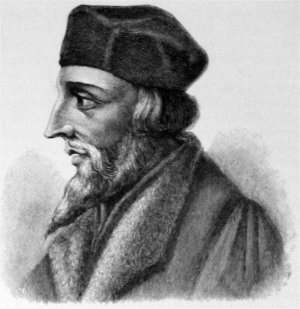
Jan Hus
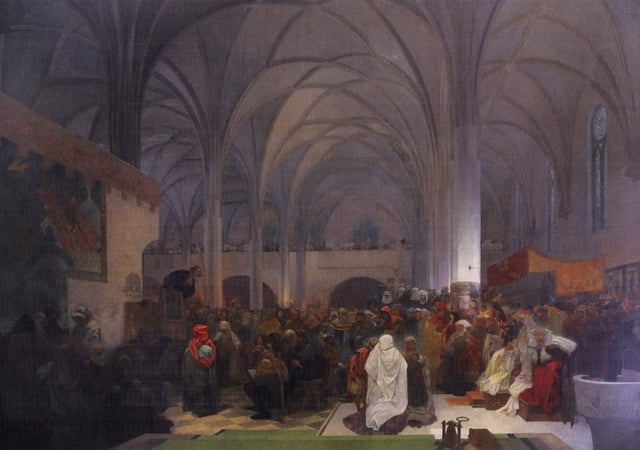
Jan Hus Preaching at Bethlehem Chapel in Prague by Alfons Mucha (1916)
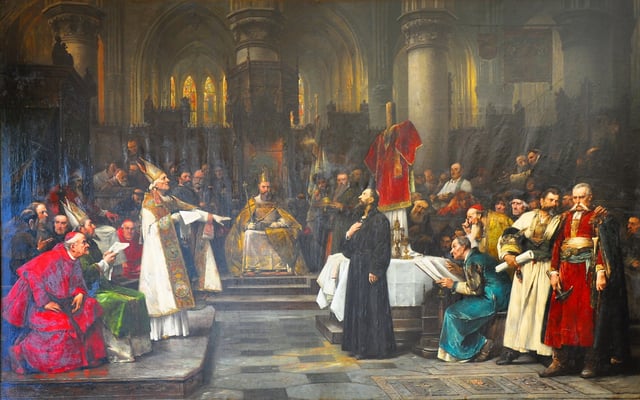
Jan Hus-Council of Constance by Václav Brožík
The Hussite movement that was to become the Moravian Church was started by Jan Hus (English: John Huss) in early 15th century Bohemia, in what is today the Czech Republic.[3] Hus objected to some of the practices and doctrines of the Catholic Church; specifically, he wanted the liturgy to be celebrated in Czech, lay people to receive communion in both kinds (bread and wine – that is, in Latin, communio sub utraque specie), married priests, and eliminating indulgences and the idea of Purgatory. Since these actions predate the Protestant Reformation by a century, some historians claim the Moravian Church was the first Protestant church.[7][8]
The movement gained support in the Crown of Bohemia. However, Hus was summoned to attend the Council of Constance, which decided that he was a heretic and released him to the secular authority, which sentenced him to be burned at the stake on 6 July 1415. From 1419 to 1437 were a series of Hussite Wars initially between various Catholic rulers and the Hussites, and then the political situation continued into a Hussite civil war between the more compromising Utraquists and the radical Taborites. In 1434, an army of Utraquists and Catholics defeated the Taborites at the Battle of Lipany. The Utraquists signed the Compacts of Basel on 5 July 1436.
Within fifty years of Hus' death, a contingent of his followers had become independently organised as the "Bohemian Brethren" (Čeští bratři) or Unity of the Brethren (Jednota bratrská), which was founded in Kunvald, Bohemia, in 1457. A brother known as Gregory the Patriarch was very influential in forming the group, as well as the teachings of Peter Chelcicky. This group held to a strict obedience to the Sermon on the Mount, which included non-swearing of oaths, non-resistance, and not accumulating wealth. Because of this, they considered themselves separate from the majority Hussites that did not hold those teachings. They received episcopal ordination through the Waldensians in 1467.[7] [] [8] [] These were some of the earliest Protestants, rebelling against Rome some fifty years before Martin Luther.[7][8] By the middle of the 16th century as many as 90 per cent of the inhabitants of the Bohemian Crown were Protestant.[9] The majority of the nobility was Protestant, and the schools and printing-shops established by the Moravian Church were flourishing.
Protestantism had a strong influence in the education of the population. Even in the middle of the 16th century there was not a single town without a Protestant school in the Bohemian crown lands, and many had more than one, mostly with two to six teachers each. In Jihlava, a principal Protestant center in Moravia, there were five major schools: two German, one Czech, one for girls and one teaching in Latin, which was at the level of a high/grammar school, lecturing on Latin, Greek and Hebrew, Rhetorics, Dialectics, fundamentals of Philosophy and fine arts, as well as religion according to the Lutheran Augustana.[10]
Counter-Reformation
With the University of Prague also firmly in hands of Protestants, the local Catholic church was unable to compete in the field of education. Therefore, the Jesuits were invited, with the backing of the Catholic Habsburg rulers, to come to the Bohemian Crown and establish a number of Catholic educational institutions. One of these is the university in the Moravian capital of Olomouc. In 1582 they forced closure of local Protestant schools.
In 1617, Emperor Matthias had his fiercely Catholic brother Ferdinand of Styria elected King of Bohemia, but in 1618 Protestant Bohemian noblemen, who feared losing their religious freedom,[11] started the Bohemian Revolt. The Revolt started by the unplanned second Defenestrations of Prague and was defeated in 1620 in the Battle of White Mountain near Prague. As consequence the local Protestant noblemen were either executed or expelled from the country while the Habsburgs placed Catholic (and mostly German speaking) nobility in their place. The war, plague, and subsequent disruption led to a decline in the population from over 3 million to some 800,000 people. By 1622 the entire education system was in the hands of Jesuits and all Protestant schools were closed.
The Brethren were forced to operate underground and eventually dispersed across Northern Europe as far as the Low Countries, where their Bishop John Amos Comenius attempted to direct a resurgence. The largest remaining communities of the Brethren were located in Leszno (German: Lissa) in Poland, which had historically strong ties with the Czechs, and small, isolated groups in Moravia. These latter are referred to as "the Hidden Seed" which John Amos Comenius had prayed would preserve the evangelical faith in the land of the fathers.
In addition to the Renewed Unitas Fratrum or Moravian Church, which preserves the Unitas Fratrum's three orders of episcopal ordination, The Evangelical Church of Czech Brethren and the Czechoslovak Hussite Church also continue the Hussite tradition in the Czech and Slovak Republics today, although they only account for 0.8% of the Czech population (which is 79.4% non-religious, and 10.4% Catholic).
Herrnhuter Brüdergemeine, 18th-century renewal
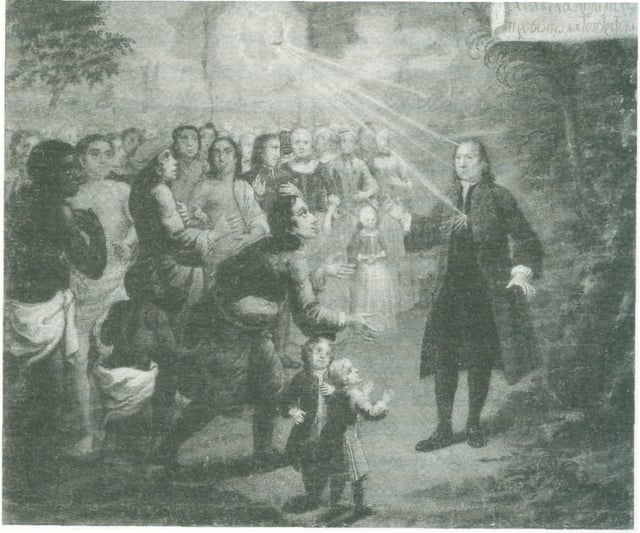
Nicolaus Zinzendorf preaching to people from many nations
In 1722, a small group of Bohemian Brethren (the "Hidden Seed") who had been living in northern Moravia as an illegal underground remnant surviving in Catholic setting of the Habsburg Empire for nearly 100 years, arrived at the Berthelsdorf estate of Nikolaus Ludwig von Zinzendorf, a nobleman who had been brought up in the traditions of Lutheran Pietism. Out of a personal commitment to helping the poor and needy, he agreed to a request from their leader (Christian David, an itinerant carpenter) that they be allowed to settle on his lands in Upper Lusatia, which is in present-day Saxony in the eastern part of modern-day Germany. The Margraviates of Upper and Lower Lusatia were governed in personal union by the Saxon rulers and enjoyed great autonomy, especially in religious questions.
The refugees established a new village called Herrnhut, about 2 miles (3 km) from Berthelsdorf. The town initially grew steadily, but major religious disagreements emerged and by 1727 the community was divided into factions. Count Zinzendorf worked to bring about unity in the town and the Brotherly Agreement was adopted by the community on 12 May 1727. This is considered the beginning of the renewal. Then, on 13 August 1727 the community underwent a dramatic transformation when the inhabitants of Herrnhut "learned to love one another", following an experience that they attributed to a visitation of the Holy Spirit, similar to that recorded in the Bible on the day of Pentecost.
Herrnhut grew rapidly following this transforming revival and became the centre of a major movement for Christian renewal and mission during the 18th century. The episcopal ordination of the Ancient Unitas Fratrum was transferred in 1735 to the Renewed Unitas Fratrum by the Unity's two surviving bishops, Daniel Ernst Jablonski and Christian Sitkovius. The carpenter David Nitschmann and, later, Count von Zinzendorf, were the first two bishops of the Renewed Unity. Moravian historians identify the main achievements of this period as:
Setting up a watch of continuous prayer that ran uninterrupted, 24 hours a day, for 100 years.
Originating the Daily Watchwords.
Establishing more than 30 settlements internationally on the Herrnhut model, which emphasized prayer and worship, and a form of communal living in which simplicity of lifestyle and generosity with wealth were held to be important spiritual attributes. The purpose of these communities was to assist the members resident there in the sanctification of their lives, to provide a meeting place for Christians from different confessional backgrounds, to provide Christian training for their own children and the children of their friends and supporters and to provide support for the Moravian Mission work throughout the world. As a result, although personal property was held, divisions between social groups and extremes of wealth and poverty were largely eliminated.
Being the first Protestant church body to begin missionary work; and
Forming many hundreds of small renewal groups operating within the existing churches of Europe, known as "diaspora societies". These groups encouraged personal prayer and worship, Bible study, confession of sins and mutual accountability.
Missions
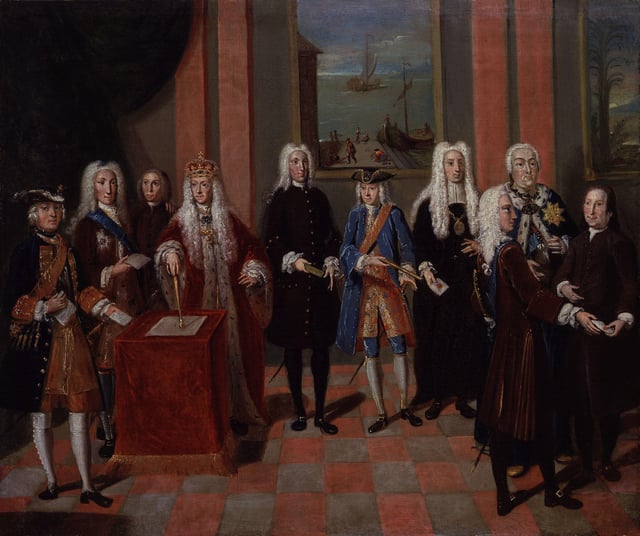
Portrait of a group of Moravian Church members with King George II of Great Britain, attributed to Johann Valentin Haidt, circa 1752–1754
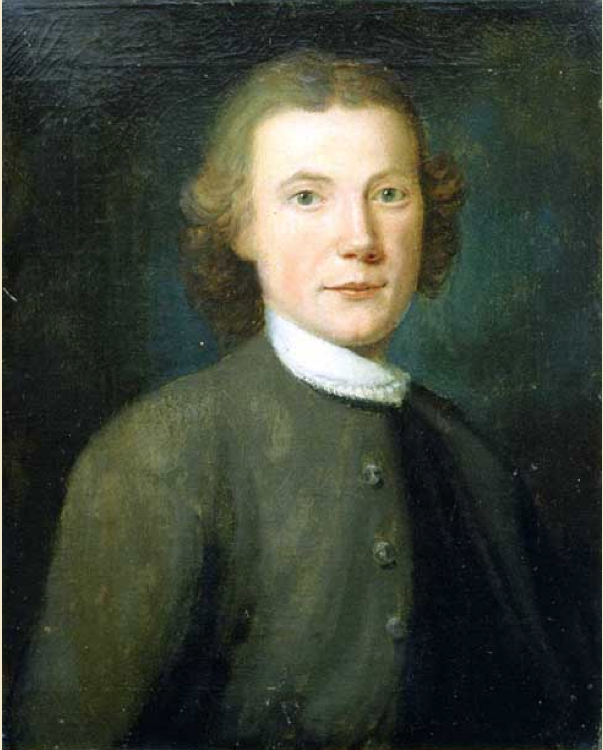
In 1772, John Ettwein[14] and his group of some 200 Lenape and Mohican Christians traveled west along The Great Shamokin Path from their village of Friedenshütten (Cabins of Peace) near modern Wyalusing on the North Branch Susquehanna River to their new village of Friedensstadt (City of Peace) [41] on the Beaver River in southwestern Pennsylvania.
Along with the Royal Danish Mission College, the Moravian missionaries were the first large-scale Protestant missionary movement. They sent out the first missionaries when there were only 300 inhabitants in Herrnhut. Within 30 years, the church sent hundreds of Christian missionaries to many parts of the world, including the Caribbean, North and South America (see Christian Munsee), the Arctic, Africa, and the Far East. They were the first to send lay people (rather than clergy) as missionaries, the first Protestant denomination to minister to slaves, and the first Protestant presence in many countries.
Owing to Zinzendorf's personal contacts with their royalty, the first Moravian missions were directed to the Dano-Norwegian Empire. While attending the coronation of Christian VI of Denmark, Zinzendorf was profoundly struck by two Inuit converts of Hans Egede's mission in Greenland and also by an African from the West Indies.[12] The first Moravian mission was established on the Caribbean island of St Thomas in 1732 by a potter named Johann Leonhard Dober and a carpenter named David Nitschmann,[13] [] who later became the first bishop of the Renewed Unity in 1735. Matthaeus Stach and two others founded the first Moravian mission in Greenland in 1733 at Neu-Herrnhut on Baal's River, which became the nucleus of the modern capital Nuuk.
Moravians founded missions with Algonquian-speaking Mohican in the British colony of New York in British North America. For instance, they founded one in 1740 at the Mohican village of Shekomeko in present-day Dutchess County, New York. The converted Mohican people formed the first native Christian congregation in the present-day United States of America. Because of local hostility to the Mohican, the Moravian support of the Mohican led to rumors of their being secret Jesuits, trying to ally the Mohican with France in the ongoing French and Indian Wars.
Although supporters defended their work, at the end of 1744, the colonial government based at Poughkeepsie expelled the Moravians from New York.[15]
In 1741, David Nitschmann and Count Zinzendorf led a small community to found a mission in the colony of Pennsylvania. The mission was established on Christmas Eve, and was named Bethlehem, after the Biblical town in Judea. There, they ministered to the Algonquian Lenape. Bethlehem, Pennsylvania is today the seventh largest city in Pennsylvania. Later, colonies were also founded in North Carolina, where Moravians led by Bishop August Gottlieb Spangenberg purchased 98,985 acres (400.58 km2) from John Carteret, 2nd Earl Granville. This large tract of land was named die Wachau, or Wachovia, after one of Zinzendorf's ancestral estates on the Danube River in Lower Austria. Other early settlements included Bethabara (1753), Bethania (1759) and Salem (now referred to as Old Salem in Winston-Salem North Carolina) (1766).
In 1801 the Moravians established Springplace mission to the Cherokee Nation in what is now Murray County, Georgia. Coinciding with the forced removal of the Cherokees to Oklahoma, this mission was replaced in 1842 by New Springplace in Oaks, Oklahoma. Due to Civil War-related violence, New Springplace closed in 1862, and resumed during the 1870s. Finally, in 1898, the Moravian Church discontinued their missionary engagement with the Cherokees, and New Springplace, now the Oaks Indian Mission, was transferred to the Danish Evangelical Lutheran Church.[16]
Eventually, the Moravian missions in Australia and Greenland were transferred to the local Presbyterian and Lutheran Churches respectively.
The first mission station in present-day South Africa was established by the Moravian Georg Schmidt at Genadendal in 1738. The mission at Wupperthal, established by the Rhenish Missionary Society was eventually transferred to the Moravian Church.
Present
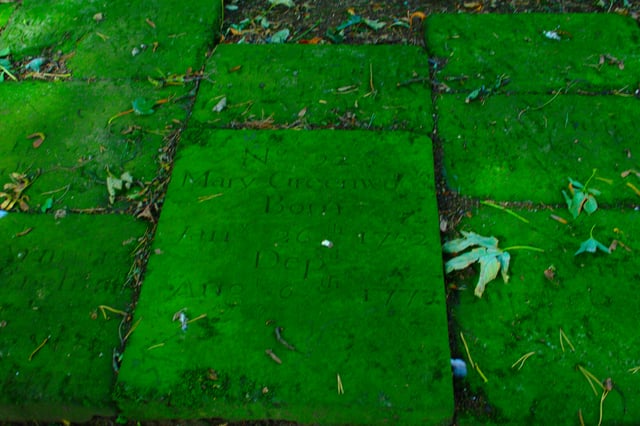
Mary Greenwoord was buried in Gracehill in County Antrim in 1752. Her gravestone is identical in style to hundreds of others irrespective of their gender or former status
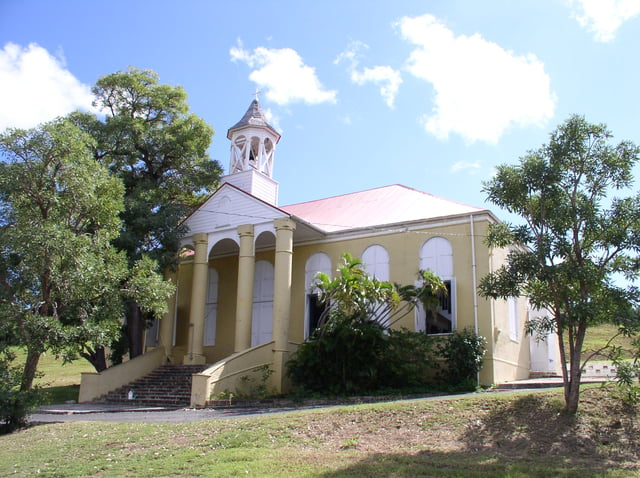
Friedensthal Moravian Church Christiansted, St Croix, USVI founded in 1755
The modern Moravian Church, with about 750,000 members worldwide,[1] continues to draw on traditions established during the 18th-century renewal. In many places it observes the convention of the lovefeast, originally started in 1727. It uses older and traditional music in worship. Brass music, congregational singing and choral music continue to be very important in Moravian congregations. In addition, in some older congregations, Moravians are buried in a traditional God's Acre, a graveyard with only flat gravestones, signifying the equality of the dead before God and organized by sex, age and marital status rather than family.
The Moravians continue their long tradition of missionary work, for example in the Caribbean, where the Jamaican Moravian Church has begun work in Cuba and in Africa where the Moravian Church in Tanzania has missions in the Democratic Republic of Congo and Uganda. This is reflected in their broad global distribution. The Moravians in Germany, whose central settlement remains at Herrnhut, are highly active in education and social work. The American Moravian Church sponsors the Moravian College and Seminary. The largest concentration of Moravians today is in Tanzania.
The motto of the Moravian Church is: "In essentials, unity; in nonessentials, liberty; and in all things, love".[17]
Some Moravian scholars point to a different formula as a guide to constructive debate about faith. This formula was first advanced by Luke of Prague (1460–1528), one of the bishops of the ancient Unitas Fratrum. Luke taught that one must distinguish between things that are essential, ministerial or incidental to salvation. The essentials are God's work of creation, redemption and sanctification, as well as the response of the believer through faith, hope and love. Things ministerial are such items as the Bible, church, sacraments, doctrine and priesthood. These mediate the sacred and should thus be treated with respect, but they are not considered essential. Finally, incidentals include things such as vestments or names of services that may reasonably vary from place to place
Organization
Provinces
For its global work, the Church is organised into Unity Provinces, Mission Provinces and Mission Areas and four regions of Africa, Caribbean and Latin America, Northern America, and Europe. The categorisation is based on the level of independence of the Province. Unity Province implies a total level of independence, Mission Province implies a partial level of supervision from a Unity Province, and Mission Area implies full supervision by a Unity Province. (The links below connect to articles about the history of the Church in specific provinces after 1732, where written.)
In the Czech Republic and Honduras occurred splits within the churches after charismatic revivals; non-charismatic minorities formed own bodies but both sides remained connected to the international church. The minority communities are listed as "mission provinces".[18]
Membership
| Provinces (year of foundation) or mission area | Congregations | Membership[2] |
|---|---|---|
| Africa | 907,830 | |
| Burundi (mission province) | 40,000 | |
| Tanzania, North (2007) | 25 | 3,910 |
| Tanzania, East (2007) | 56 | 28,510 |
| Tanzania, Rukwa (1986) | 60 | 66,410 |
| Tanzania, South (1891) | 170 | 203,000 |
| Tanzania, South West (1978) | 211 | 300,000 |
| Tanzania, Lake Tanganyika (2005) | 30 | 32,100 |
| Tanzania, West (1897) | 61 | 104,000 |
| Zambia (1989) | 17 | 5,210 |
| South Africa (1792/1737) | 87 | 98,000 |
| Congo/DR Congo (2005) | 80 | 21,500 |
| Malawi (2007) | 10 | 5,190 |
| Caribbean & Latin America | 204,980 | |
| Costa Rica (1980/1941) | 3 | 1,900 |
| Guyana (1878/1835) | 960 | |
| Honduras (1930) | 85 | 34,450 |
| Jamaica (1754) | 65 | 8,100 |
| Nicaragua (1849) | 226 | 97,000 |
| Surinam (1735) | 67 | 30,000 |
| Eastern West Indies (1732) Trinidad, Tobago, Barbados, Antigua, St. Kitts, and the Virgin Islands including St. Croix, St. John, St. Thomas, Tortola and Grenada | 52 | 15,100 |
| Honduras (Mission Province) | 16,870 | |
| Cuba (1997) (Mission Province) | 600 | |
| North America | 39,150 | |
| Alaska -1885 | 22 | 1,690 |
| America (North) (1741/1735) Greenland, Canada and the Northern States of the USA | 89 | 20,530 |
| America (South) (1753) Southern States of the USA | 55 | 15,030 |
| Labrador (1771/1752) (mission province) | 1,900 | |
| Europe | 20,180 | |
| European Continental (1727) Germany, the Netherlands, Denmark, Sweden, Switzerland, Albania, Estonia, Latvia | 24 | 14,530 |
| British (1742) Great Britain and Ireland | 30 | 1,200 |
| Czech Republic (1862/1457) | 29 | 3,800 |
| Czech Republic/Herrnhut Seniority (mission province) | 650 | |
| Missiones Areas Belize, French Guyana, Garifuna, Haiti, Kenya, Northern India & Nepal, Rwanda, Zanzibar, Sierra Leone, Tanzania Kiwele Region, Kivu and Katanga in DR Congo, Tanzania Iringa Region; Tanzania Ruvuma/Njombe Region, Uganda, Peru | 25,000 | |
| Total | 1,112,120 |
Other areas with missions but that are not yet established as Provinces are:
Star Mountain Rehabilitation Centre, Ramallah, Palestine – under the care of the European Continental Province. Work began among people with leprosy in 1867 at the Jesus Hilfe (Jesus help) home in Jerusalem, responsibility for which was taken over by the Israeli state. In 1980, the former leper home on Star Mountain was converted for use as a home for handicapped children of the Arab population.[19]
South Asia [North India (Ladakh, Dehradun, Delhi), Nepal, Assam, Manipur] – under the care of the British Province. Formerly the West Himalayan Province (1853) and designated a Unity Undertaking in 1967.
Tanzania is divided into seven provinces because of the size of country and the numbers of people in the church. The "Moravian Church in Tanzania" co-ordinates the work in the nation.
The lists above, except for some details given under 'Other areas', can be found in The Moravian Almanac.[19]
Each Province is governed by a synod, made up of representatives from each congregation plus ex officio members.
The Synod elects the Provincial Board (aka Provincial Elders' Conference or PEC[20]) to be responsible for the work of the Province and its international links between Synods.
Districts
Many, but not all, of the Provinces are divided into Districts.
Congregations
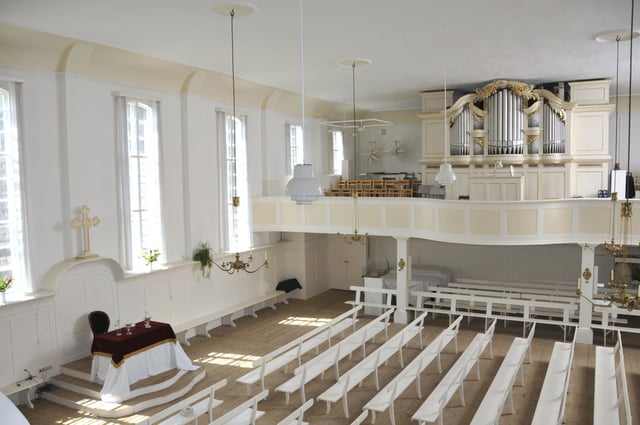
A Moravian church in Neudietendorf in Thuringia in Germany
Each congregation belongs to a district and has spiritual and financial responsibilities for work in its own area as well as provincially. The Congregation Council (all the members of a congregation) usually meets twice a year and annually elects the Joint Board of Elders and Trustees that acts as an executive.
In some provinces two or more congregations may be grouped into circuits, under the care of one minister.
Unity Synod
The Unity Synod meets every seven years and is attended by delegates from the different Unity Provinces and affiliated Provinces.
Unity Board
The Unity Board is made up of one member from each Provincial Board, and acts as an executive committee between Unity Synods. It meets three times between Synods but much of its work is done by correspondence and postal voting.
The President of the Unity Board (who is elected by the Board for two years and not allowed to serve for more than two terms) works from his/her own Provincial office. The Unity Business Administrator is an officer appointed by the Unity Board to administer the day-to-day affairs of the Unity through the office of the Unity.
Orders of Ministry
Ordained ministry in the Moravian Church emphasizes the pastoral role. A candidate for ministry who has been approved by their home province and has completed the prescribed course of study (usually a Master of Divinity degree in the US and Europe) may be ordained a Deacon upon acceptance of a call. Deacons may serve in a pastoral office and administer sacraments. A deacon is normally supervised by a presbyter who serves as mentor. After several years of satisfactory service, the Deacon may be consecrated as a Presbyter. Presbyters function in the local congregation in the same manner as deacons, but may also serve to mentor deacons and may be assigned to other leadership roles in a particular province.
An Acolyte is a layperson who has received approval to assist the pastor in a specific local congregation. The acolyte may assist in the serving of Holy Communion but may not consecrate the elements.
The highest order of ministry is that of a bishop. Bishops are elected by Provincial Synods usually through ecclesiastical ballot without nomination. In the Moravian Church, bishops do not have an administrative role but rather serve as spiritual leaders and pastors to the pastors. Bishops serve the worldwide Unity.[21] The Moravian Church is reputed to have received the apostolic succession through the Waldensian Church, but the historicity of this is disputed. In Berlin, 1735, the Renewed Unity, i.e. the Moravian Brethren in Herrnhut, received the historic episcopal ordination from the two surviving bishops of the Ancient Unity: Bishop John Amos Comenius' grandson Daniel Ernst Jablonski and Christian Sitkovius. This bishop's consecration continues today.
Beliefs
The three Ecumenical Creeds: Apostles', Nicene and Athanasian
The first 21 articles of the Unaltered Augsburg Confession
The Confession of the Unity of the Bohemian Brethren of 1535
The Barmen Declaration of 1934
The Small Catechism of Martin Luther
The Synod of Berne of 1532
The Thirty-Nine Articles of the Church of England
The Heidelberg Catechism
The Holy Trinity: the Father, the Son or Logos/Word, and the Holy Spirit.
The Fatherhood of God
God's Love for fallen humanity
The Incarnation of God in the God/Man Jesus Christ
Jesus' sacrificial death for the sinful rebellion of humanity
Jesus' Resurrection, Ascension and Exaltation to the Right Hand of the Father
Jesus' sending of the Holy Spirit to strengthen, sustain and empower believers
Jesus' eventual return, in majesty, to judge the living and the dead
The Kingdom of Christ shall never end
There is one Baptism for the forgiveness of sins. Rebaptism is not allowed.
Infants are baptized most commonly, but all forms of baptism are accepted (infant or adult; pouring, sprinkling or immersion).
Moravian doctrine teaches that the Body and Blood of Christ are present in Holy Communion. Without seeking to explain the "Mode" or the "How" of the Presence of Jesus' Body and Blood in the Eucharist, they teach a sacramental union whereby with the Bread and the Wine the Body and Blood are also received. Individual believers are allowed to believe in other interpretations, however. Cf. the "Easter Morning Litany" of the Moravian Church, a statement of faith, in the Moravian Book of Worship, p. 85.
These tenets of classical Christianity are not unique to the Moravian Church. The emphasis in both the Ancient Unity and the Renewed Unity is on Christian living and the fellowship of believers as a true witness to a vibrant Christian Faith.
Spirit of the Moravian Church
An account of the ethos of the Moravian Church is given by one of its British bishops, Clarence H. Shawe.[24] In a lecture series delivered at the Moravian Theological Seminary in Bethlehem, Pennsylvania, Shawe described the Spirit of the Moravian Church as having five characteristics: simplicity, happiness, unintrusiveness, fellowship, and the ideal of service.
Simplicity is a focus on the essentials of faith and a lack of interest in the niceties of doctrinal definition. Shawe quotes Zinzendorf's remark that "The Apostles say: 'We believe we have salvation through the grace of Jesus Christ....' If I can only teach a person that catechism I have made him a divinity scholar for all time" (Shawe, 1977, p. 9). From this simplicity flow secondary qualities of genuineness and practicality.
Happiness is the natural and spontaneous response to God's free and gracious gift of salvation. Again Shawe quotes Zinzendorf: "There is a difference between a genuine Pietist and a genuine Moravian. The Pietist has his sin in the foreground and looks at the wounds of Jesus; the Moravian has the wounds in the forefront and looks from them upon his sin. The Pietist in his timidity is comforted by the wounds; the Moravian in his happiness is shamed by his sin" (p. 13).
Unintrusiveness is based on the Moravian belief that God positively wills the existence of a variety of churches to cater for different spiritual needs. There is no need to win converts from other churches. The source of Christian unity is not legal form but everyone's heart-relationship with the Saviour.
Fellowship is based on this heart-relationship. Shawe says: "The Moravian ideal has been to gather together kindred hearts.... Where there are 'Christian hearts in love united', there fellowship is possible in spite of differences of intellect and intelligence, of thought, opinion, taste and outlook. ... Fellowship [in Zinzendorf's time] meant not only a bridging of theological differences but also of social differences; the artisan and aristocrat were brought together as brothers and sat as equal members on the same committee" (pp. 21,22).
The ideal of service entails happily having the attitude of a servant. This shows itself partly in faithful service in various roles within congregations but more importantly in service of the world "by the extension of the Kingdom of God". Historically, this has been evident in educational and especially missionary work. Shawe remarks that "none could give themselves more freely to the spread of the gospel than those Moravian emigrants who, by settling in Herrnhut [i.e., on Zinzendorf's estate], had gained release from suppression and persecution" (p. 26).
Worship
Hymn Books
Liturgy
the Sacrament of the Holy Communion
The Sacrament of Baptism, Infants and Adults
Marriage
Confirmation
Christian Burial
Ordination Bishops, Presbyters and Deacons
Consecration of church buildings and facilities
Traditions
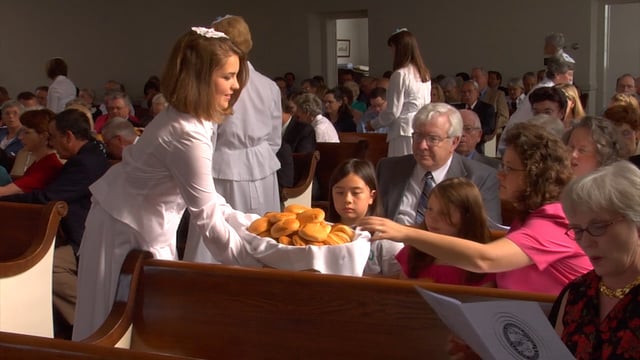
A Moravian diener serves bread to fellow members of her congregation during the celebration of a lovefeast.
Lovefeast
Cup of Covenant
Christingle (object) and Christingle service
Hosanna Anthem
Moravian Advent star
Daily Watchwords, sometimes called Moravian Daily Texts
Advent Wreath and Candles
Passion Week/ Holy Week Reading Services
God's Acre and Easter sunrise service
Drawing of lots
Music
Watch Night Service
Dead house
Former traditions
Settlements
The drawing of "lots" in decision making
Single Brethren's and Single Sisters' Houses: in the old original Settlement Congregations of Europe, Britain and the US, there were separate Houses caring for the spiritual and also temporal welfare of the Choirs of Single Brethren, Single Sisters, Widows.[25]
Wide/Short layout of church interiors
Separate seating of sexes in churches
Mission ships (the Harmony and the Snow Irene)
Choirs: the word "Choir" has been used in the Moravian tradition since the 18th century to indicate a group of congregation members classified according to age and sex. Formerly there were in several congregations separate Houses caring for the spiritual and also temporal welfare of the Choirs of Single Brethren, Single Sisters, Widows.[25]
Uniformed and other organizations
Boys' Brigade / Scouts
Girls' Brigade / Guides / Upward & Onward
Women's Fellowship
Men's Fellowship
Sunday School
Young People's Missionary Association (YPMA)
Prominent Moravians
Bishops
Missionaries
Writers
Artists
Ecumenical relations
The Moravian Church provinces are members individually of the World Council of Churches and the Lutheran World Federation. Most provinces are also members of their national councils of churches, such as the Evangelische Kirche in Deutschland (EKD) in Germany and the National Council of Churches of Christ in the US, the all African Council of Churches, the Caribbean Council of Churches, the Jamaica Council of Churches. The American Southern Province was instrumental in the founding the North Carolina Council of Churches. The British Province is of the Churches Together in Britain and Ireland (formerly the British Council of Churches) and has an interim Communion agreement with the Church of England. The two North American provinces are in full communion with the Evangelical Lutheran Church in America (ELCA). The Northern Province of the Moravian Church voted June 18, 2010 to enter into full communion with the Episcopal Church. The Moravian Church's Southern Province also voted to enter into full communion with the Episcopal Church during its synod in September 2010. Each province can independently enter into full communion relationships.[26] In the 1980s there were discussions in England by which an agreement was created that would have created full communion between the Moravians, Presbyterians, Methodists, and the Church of England. The Presbyterians and Methodists would have accepted the Historic Episcopate, but since the Moravians already had this, they would have changed nothing. This agreement fell through because the General Synod of the Church of England did not give approval.
One aspect of Moravian history and mission is the so-called "Diaspora" work in Germany and Eastern Europe, seeking to deepen and encourage the Christian life among members of the territorial churches, particularly in Poland and the Baltic states, but also throughout the German-speaking lands. Count Zinzendorf's ideal was a fellowship of all Christians, regardless of denominational names, and the Moravian Brethren sought in the Diaspora not to convert people to the Moravian Church but to awaken the hearts of believers and make them better members of the churches to which they already belonged. At first the object of suspicion, in the course of time the Moravian Diaspora workers became valued co-workers in eastern Europe. This Diaspora work suffered almost total destruction in World War II, but is still carried on within the territorial churches of Germany. With the independence of Estonia and Latvia, it was revealed that much of the Diaspora Work there had been kept alive in spite of domination by the former Soviet Union and had even borne fruit.
Historical societies
American North: the Moravian Historical Society and Historic Bethlehem (Pennsylvania)
American South: the Wachovia Historical Society as well as Old Salem
British: Defunct.
Continental Province Verein für Geschichts- und Gegenwartsfragen der Brüdergemeine
„Via exulantis", Suchdol nad Odrou (Zauchtenthal or Zauchtel), The Moravian Brethren's Museum. The permanent exposition of the exile of 280 inhabitants from Suchdol nad Odrou to Herrnhut in Saxony in the 18th century, where they renewed the Unity of the Brethren and then established missionary establishments in all parts of the world.
Publications
Herrnhuter Bote (former title: der Brüderbote), the periodical of the Continental Province
Unitas Fratrum, the publication of the Continental Province's historical society
the Moravian Magazine, the publication of the North American Provinces
The Moravian Voice, a publication of the Moravian Church in Jamaica
the Moravian Messenger, periodical of the British Province
Moravian History Magazine – published within the British Province but deals with the work worldwide.
Journal of Moravian History[27] – scholarly journal, published by the Moravian Archives.[28] in Bethlehem, PA, and the Moravian Historical Society[29] in Nazareth, PA.
See also
University of Olomouc, established in 1573 as Jesuit University in order to re-Catholicize Moravian population
Ronneburg, Hesse
Christian Munsee
Bethlehem, PA
Old Salem
Minor Party (Unity of the Brethren)